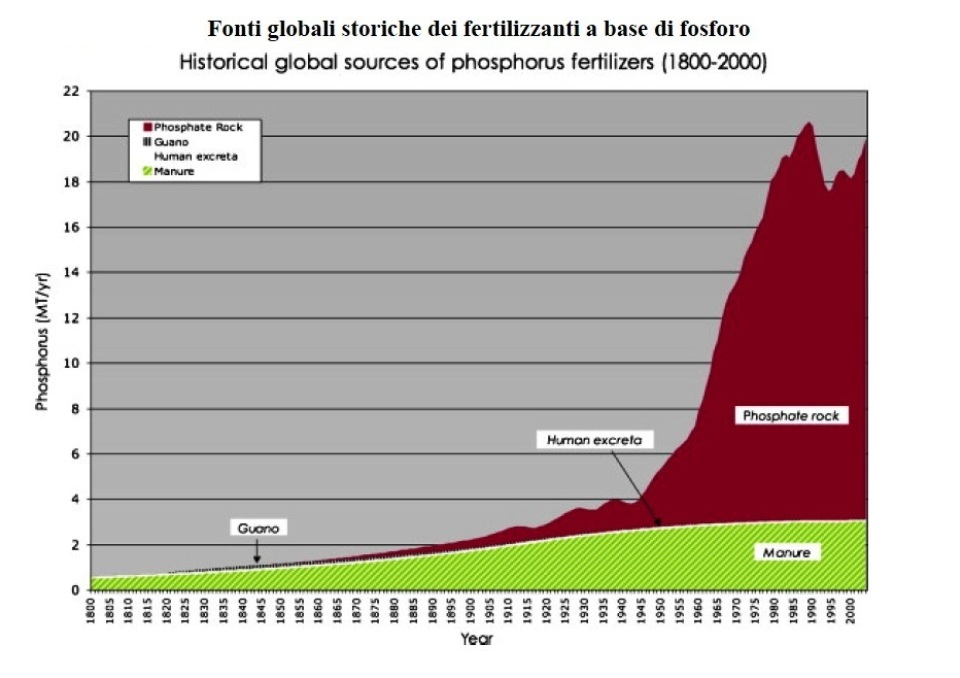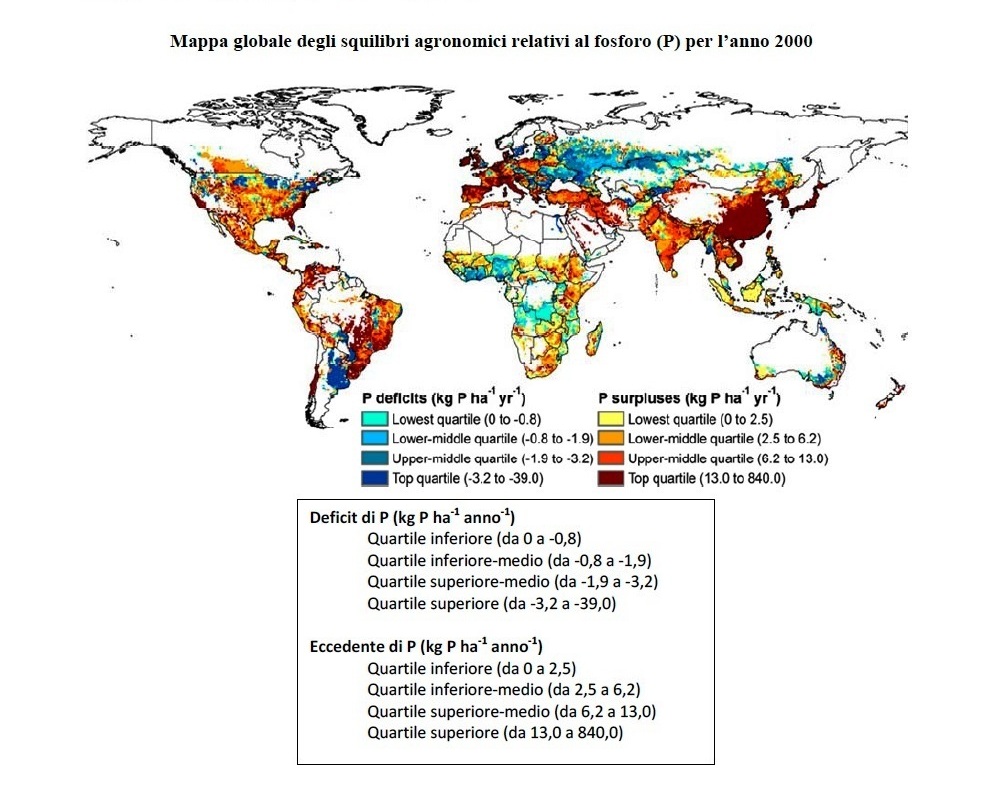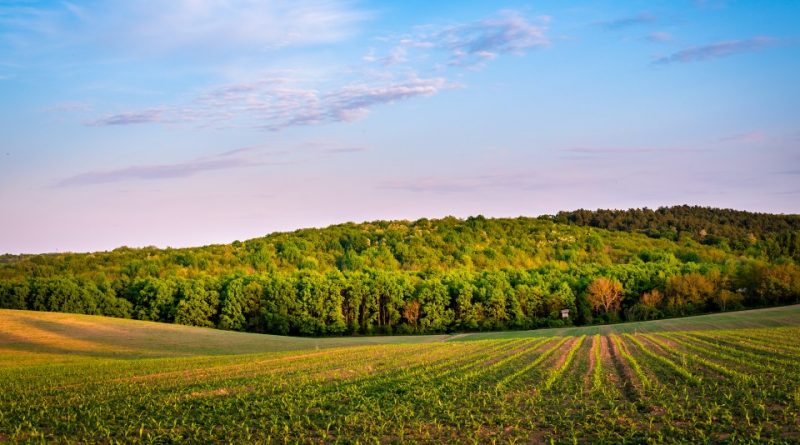Availability of phosphates and threats to agricultural production
Availability of phosphates and threats to agricultural production
As is known from the reports of some government bodies, such as the Communication from the Commission to the European Parliament and the Committee of the Regions of 2013 (on the sustainable use of phosphorus), the phosphorus crisis for fertilizers threatens world agricultural production.
The scarcity of the most used element (together with potassium and nitrogen) to make fertilizers, together with the ecological crisis and the still slow application of agro-ecological techniques, risks bringing the food chain to its knees in a few decades.
Furthermore, the increase in the use of this fertiliser, exponentially grown with the advent of intensive agriculture from the 60s onwards of the last century, has led to a considerable increase in the need for water and energy (for the extraction and distribution ) with an increasingly negative impact on climate-changing emissions.
Phosphorus is, in fact, one of the elements most commonly used to produce fertilizers, together with nitrogen and potassium. It is mainly extracted from rocks and phosphate sands, which are transported and processed (using large quantities of water and energy) until monoammonium and diammonium phosphate are obtained, the basic ingredients of many fertilizers. The yields of industrial agriculture are largely based on the availability of this element. Phosphate reserves have two fundamental characteristics:
– are concentrated in very few places in the world – 70% in Morocco, 20% in 4 other countries, only the remaining 10% in the rest of the world.
– due to a competition of factors they are running out.
The phenomenon is known as “peak phosphorus” or “peak phosphate” and has been talked about for several years. The first studies on the subject hypothesized that the peak, i.e. the moment of maximum extraction before the decline, would have already arrived around 2010. Subsequently, the estimates were revised upwards, but there is no certainty as to when the phosphorus peak will occur. Currently, the most reliable studies place it between 2030 and 2100, with the large margin of uncertainty due to two factors: the estimates relating to reserves and – above all – the projections linked to consumption.

Fortunately, in Italy and in Europe, the demand for phosphorus has decreased over the last 15 years, also thanks to the contribution of organic farming and, more recently, the advent of agroecology, but in the rest of the world it has continued to grow, driven from the emerging economies of China and India, from the growth in meat consumption in countries experiencing economic expansion (meat which has a phosphate footprint 50 times higher than vegetables) and from the use of so-called biofuels.
Obviously, the growth in demand, which does not correspond to a growth in supply, has caused the price to rise, which has more than doubled in the last 15 years. And the trend does not seem to stop: if targeted policies are not taken, the demand for phosphorus fertilizers is destined to double by 2050, and with the supply starting to decline, the world food supply chain risks ending up in chaos. Faced with this apocalyptic picture, various institutions have moved in search of solutions. In 2013, the European Sustainable Phosphorus Platform (ESPP) was born, a platform that brings together a wide range of European players along the entire phosphorus chain with the aim of finding shared solutions for more efficient management of the resource.
Obviously the solution to the phenomenon is not so immediate, in the meantime due to the weak impact of World Policy in the agricultural sector, such as the CAP in Europe, and due to other factors which are often of complex weighting.
Among these the decrease, among other living beings, of birds. According to BirdLife International, the Ornithological Society of the Czech Republic and the Royal Society for the Protection of Birds (RSPB), since 1980, intensive agriculture and other human activities in Europe have made disappear between 600 and 900 million specimens of the most bird communities: basically one out of six. With their decrease, their natural intake has drastically decreased, especially of phosphates and nitrates, as confirmed by the Departamento de edafoloxía e química agrícola of the Universidade de Santiago de Compostela.
Add to this the 45 percent collapse of insect populations in the last decade. The journal Science has tried to quantify the decline by calculating a summary of the results of various scientific studies that have already been concluded: the result, for some species monitored, was, to say the least, worrying.
The decrease in the populations of birds, especially seabirds, with their intake of guano, notoriously very rich in phosphorus, and of insects, whose body is rich in the same element, as well as other elements essential for the balance of soil fertility, it has upset a delicate balance which has remained practically unchanged in the last ten thousand years of agricultural history.
Among other things, with regard to the decline in bird populations, according to the calculations of some researchers, their droppings can also be quantified monetarily, equivalent to over 1 billion dollars a year.
Scientists put a price on guano’s global benefits, ranging from natural fertilizers to enriching coral reefs.
The study “Valuing ecosystem services can help to save seabirds”, published in Trends in Ecology and Evolution by Daniel Plazas-Jiménez and Marcus Cianciaruso of the Universidade Federal de Goiás, shows that seabird guano is a great resource: it contains nutrients that stimulate the soil, gave rise to Inca agriculture and supported it for centuries and then, when European colonists discovered it, it ushered in the era of guano imperialism which is still sold as fertilizer today organic.
Other studies, carried out by other researchers in various parts of the world, have underlined how the disruption of ecosystem balances is increasingly negatively affecting the redistribution of nutrients, which cannot be compensated now or ever by a linear and non-circular agricultural model.
Unfortunately, the governance of global policies and decisions on agricultural models is poorly supported by sufficient dissemination and information on research which, to tell the truth, is often not even listened to.
All of this, in addition to ecological and agricultural imbalances, risks increasing human and political disparities, as is already happening in some countries, especially in the tropical and equatorial belt, generating an escalation of internal and international conflicts.

Yet the scientific and ethical foundations for overcoming this massive vortex that world civilization has been feeding have existed for years; they have been known since the beginning of the 80s of last year; are represented by the implementation of a solid circular economy, by the application of agro-ecological techniques and by the democratic balance between rich and poorer populations.
We now know that all these factors would guarantee not only an increase in production yields (also in agriculture) but above all a better performance of energy processes, which the open thermodynamic cycles of the circular economy can no longer ensure.
The innovations linked to the discoveries of the last decades must be translated into political language and action; to do this, it must be purified from the harmful interference of large economic interests that increasingly resemble the biblical pursuit of the Jews by the Egyptian pharaoh’s horses, Egyptians who were swallowed up, according to the story, by the return of the waters which “…submerged the chariots and the knights of all the pharaoh’s army …”.
Thus the interests of the multinationals do not seem to understand the probable fate that awaits them and for this reason we need a real awareness on the part of the population towards an “exodus” that allows us to enter a “promised” land for future generations.
Guido Bissanti

